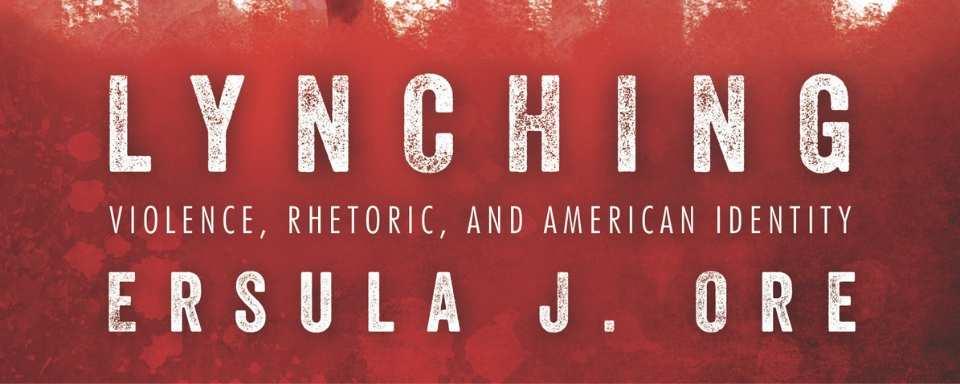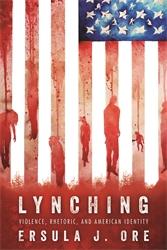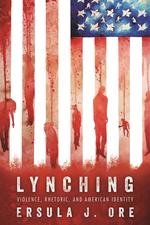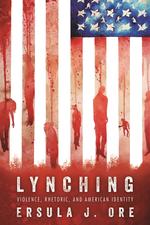
Ersula J. Ore on Lynching
There is a commonplace (il)logic that informs the intentionally incendiary remarks issued by politicians and public figures, an (il)logic that not only reminds us of the power of words, but of the power of false equivalencies. An impeachment is not a lynching—“high-tech” or otherwise. It is neither an act of white solidarity intimately tied to notions of national and civic identity, nor is it fueled by rhetoric that proclaims white innocence at the expense of Black life. To assert otherwise not only empties lynching of its meaning but commits lynching victims past and present to additional violence. The ease with which such fallacies, such untruths are espoused must be recognized as their adoption holds detrimental consequences for democracy.
Below is an excerpt from the introduction of Lynching: Violence, Rhetoric, and American Identity.
Why Lynching? Why Now?
Lynching is largely thought to be a part of America’s long-ago past as opposed to its immediate present. This is in part due to the culture of silence and shame that contributed to the decline of American lynching during the 1930s and in part to the advent of “end-of-lynching discourse in the 1940s.59 Prior to the 1930s, anti-lynching advocates defined lynching through focused attention to questions around guilt, complicity, and social responsibility. While advocates agreed that lynching must be stopped, they had difficulty agreeing on what constituted a lynching. As Rushdy explains, early debates over the definition of lynching exhibited a distinction between form and motive—advocates focused on form defined lynching as a practice comprising “a narrow ambit [sic] of guilty actors (the Samaritan model),” while advocates focused on motive proposed “an expanded range of responsibility” that rendered spectators equally complicit with lynchers in the act.60 Focused attention on form over motive reflected greater investment in recuperating a damaged national ethos than safeguarding the lives of black citizens.
Because lynching had for so long been a barometer of race relations, the decline of lynching had come to be desired primarily for what that decline would indicate about the state of the nation. A lynch-free year . . . meant a year that America had become better and less racist . . . that we lived in a new era, or at least not in a past or bygone one.61
It is partly because of this rhetorical campaign to save face that the killings of Amadou Diallo (1999), Patrick Dorismond (2000), Trayvon Martin (2012), Eric Garner (2014), Michael Brown (2014), Tamir Rice (2014), Samuel DuBose (2015), Walter Scott (2015), Keith Scott (2016), Philando Castile (2017), and Stephon Clark (2018), among others, are defined as instances of “self-defense,” “legal shooting,” or “benign” policing as opposed to lynchings.
In its 2016 report, the United Nations’ Working Group of Experts on People of African Descent declared antiblack police brutality to be part of America’s tradition of lynching. Defining lynching as “a form of racial terrorism that has contributed to a legacy of racial inequality that the US must address,” the panel concluded that “contemporary killings and the trauma it creates are reminiscent of the racial terror lynchings of the past. Impunity for state violence has resulted in the current human rights crisis and must be addressed as a matter of urgency.”62 The panel’s conclusions reinforced findings from a similar report issued by Montgomery, Alabama’s Equal Justice Initiative (EJI), a research and advocacy group that challenges racial injustice through its work to eradicate mass incarceration and excessive punishment, and its activism on behalf of marginalized and impoverished communities.63 Chief to its mission is educating policy makers on the ways America’s history of lynching continues to impact African Americans. In “Lynching in America: Confronting the Legacy of Racial Terror,” the EJI detailed the ways lynching “shaped the contemporary geographic, political, social, and economic conditions of African Americans” and how “[m]ass incarceration, racially biased capital punishment, excessive sentencing, disproportionate sentencing of racial minorities,” and antiblack policing reveal how contemporary race relations have been “shaped by the terror era.”64
Like those of the past, contemporary proponents of end-of-lynching discourse focus on form as opposed to motive as a means of disrupting the continuity between America’s “terror era” and the forms such terrorism takes today. The May 2017 killing of Richard Collins III at the University of Maryland exhibits this interpretative practice. Collins was standing at a campus bus stop with friends when Sean Urbanski, a University of Maryland student and white supremacist, stabbed him. Collins, a soon-to-be graduate of Bowie State University, was to start his commission as a second lieutenant in the U.S. Army later that May. When The Nation’s Dave Zirin referred to Collins’s death as a lynching, he was summarily challenged. According to critics, Collins’s death wasn’t a lynching because Urbanski didn’t use a rope to kill him; he used a knife.65 Historical ignorance aside (lynchings consisted of shootings, stabbings, and burnings as well as hangings), the preoccupation with form evidenced in the “knife over rope” rationale, dismisses the motive that links Collins’s killing to the historical and systemic practice of lynching and that practice to a tradition of American identity.
The August 2017 “wounding” of a biracial eight-year-old in Claremont, New Hampshire, offers another iteration of this discourse. Quincy and his eleven-year old sister, Ayanna, were playing with four white boys when the boys decided to enact a lynching. Parents of a white teen accused of lynching Quincy said their son never encouraged the fourth-grader to get on the table and put his head in the noose, and that once it was around his head, never pushed the boy and let him hang. They also denied that their son, along with others, used racial slurs and threw rocks and sticks at Quincy days prior to the incident.66 According to thirty-three-year-old Rhianna Larkin and thirty-two-year-old Eric Sullivan, their eleven-year-old-son was innocent because they had not raised him to hold racist views or to treat black members of their family differently. Larkin cited her father’s half-sisters and her boyfriend’s sister-in-law as proof that her son wasn’t racist.67 As she explained, it was a “complete backyard accident,” there was no racial animus involved.68 Here, preoccupation with form—“this is not a lynching, but rather just boys playing”—manifests as a semantic move to save face. Rhianna Larkin’s “we can’t be racist because we have black family” rationale—which is offered as proof of her son’s good moral character—dismisses the perception that race had any bearing on his actions. As Rhianna explained, this couldn’t be a lynching because her son doesn’t see race.69
Like those of the past, contemporary opponents of end-of-lynching discourse contended that lynching merely changed as opposed to ended. In an opinion piece on the hanging of eight-year-old Quincy, interracial parents Sindiso Minsi Weeks and Dan Weeks of New Hampshire highlighted how mainstream news outlets avoided calling the event “by its name” despite reports of taunting by the boys who allegedly hanged Quincy, despite the ways these alleged tormentors enacted white solidarity and belonging in their shared act of racially motivated violence against Quincy, and despite the ways police indifference to the pursuit of justice for Quincy mimicked the past.70 According to the Weekses, what happened in Claremont was not a wounding or a hanging; it was an “attempted lynching.”71
Reporter Dave Zirin, in “Why I Called the Murder of Richard Collins III a Lynching,” asserted that calling Collins’s death by name was
important both definitionally and politically. . . . If we don’t see Richard Collins III in the centuries-old continuum of lynchings, we are helping whitewash what took place. We are categorizing what happened as an aberration in the “post-racial” 21st-century United States. . . . To say otherwise obscures the fact that this living tradition of violent white supremacy is currently being nurtured from the campus to cable news to the White House.”72
While the trial against Sean Urbanski in the killing of Richard Collins III is scheduled to begin later this year, the verdicts of so many other trials featuring the killing of innocent black men have already been delivered. The general consensus regarding the precepts of American democracy is that they were deficient in practice but perfect in notion—impacted most ardently by human imperfection as opposed to human conceptualization. The experienced reality of democracy, however, is not that it is imperfect, but that its imperfections strategically target members of the polity not originally conceived as members of the polity. My purpose in Lynching: Violence, Rhetoric, and American Identity, then, is to center lynching as a material and rhetorical performance that illustrates the mutually constitutive relationship between democracy and antiblack violence. In doing so I aim to demonstrate the ways lynching and its rhetorics have been and remain interwoven both with the formation of America’s national identity and with the nation’s need to continually renew that identity.
Like lynchings in the past, lynchings at the turn of the twenty-first century continue to characterize American identity and citizenship belonging as the ability to kill blacks with impunity.73 While officers and civilians responsible for the “shooting deaths” of Amadou Diallo (1999), Patrick Dorismond (2000), Trayvon Martin (2012), Mike Brown (2014), Tamir Rice (2014), and Philando Castile (2016) saw time in court, they were neither found guilty nor decertified as policemen.74 Instead they were promoted or transferred; even those who had been terminated were allowed to continue working as officers in other counties. The trials that did go forward did more to prosecute victims than perpetrators, while the wrongful death suits that followed—which for many was the most readily available means of compelling accountability—simply quantified black life in ways reminiscent of the auction block.75 The historical and successive nature of lynching belies lofty narratives of racial progress to illustrate how antiblack violence shares a relationship of interiority with the making and maintenance of the nation and its people.
The question “Why lynching, why now?” then, reflects a common misreading of our contemporary moment, as it implies that lynching is over, that it is a thing of the past, and that this past has no material or symbolic bearing on the present. This book disturbs such thinking by illustrating how lynching continues to function rhetorically as a performance of American identity, constitutively as a practice of civic supremacy and citizenship belonging, and epideictically as a kind of racialized civic pedagogy and a blueprint for civic life.
Learn more about Lynching here: https://www.upress.state.ms.us/Books/L/Lynching





Comments